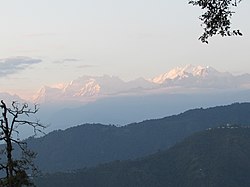Namchi district | |
|---|---|
 Mountain view at Ravangla in Namchi district, Sikkim | |
Location in Sikkim | |
| Coordinates: 27°10′N88°22′E / 27.167°N 88.367°E | |
| Country | |
| State | |
| Headquarters | Namchi |
| Government | |
| • District Collector (DC) | Shri M. Bharani Kumar [1] |
| Area | |
• Total | 750 km2 (290 sq mi) |
| Population (2011) | |
• Total | 146,850 |
| • Density | 200/km2 (510/sq mi) |
| Time zone | UTC+05:30 (IST) |
| ISO 3166 code | IN-SK |
| Vehicle registration | SK-04, SK-05 |
| Website | namchi |
Namchi district [2] is a district of the Indian state of Sikkim. Its headquarters is at Namchi.





